|
|
Home →
Survival →
Fire →
Fire Pistons
Fire Piston by Ron White
The fire piston shown on this page was made by Ron White (Toronto, Ontario)
|
|
|
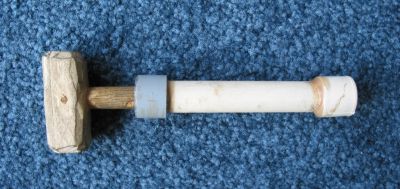 |
This fire piston is made from a PVC
tube parts with a cap at one end and sort of a funnel at the other.
It's not meant to be pretty; it's
meant to be functional, and was built from materials that are easy
and inexpensive to obtain at a local hardware store. Therefore, this
is not a "primitive survival" fire piston, ie, not made from natural
materials. The main pipe is PVC pipe - 1/2"
plastic |
|
|
|
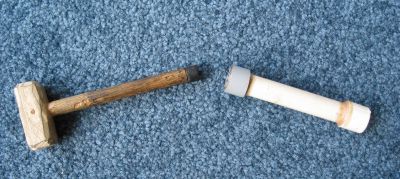 |
The plunger is made of a
wood dowel with a hand-carved handle attached with glue. It is 7/16"
in diameter. |
|
|
|
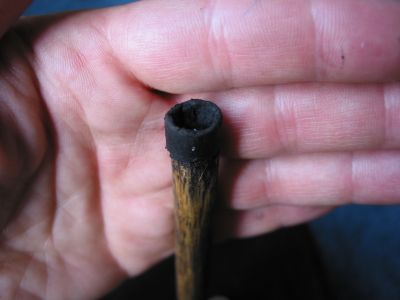 |
The end of the dowel that
fits into the cylinder has a leather cup on the end to hold the
tinder. It is attached with a screw. For tinder you can use tinder fungus or
char-cloth.
The cup shape of the leather is obtained by cutting a leather
disc, affixing it with a screw to the end of the dowel, oiling the
leather, and then pulling this assembly through successively smaller
holes, in order to force the leather into the cup shape. I don't
what kind of leather was used in this one.
The dowel needs to be lubricated (that's the black
streaks that are visible on it). This helps it move in the cylinder
more easily and also provides a better seal (the whole fire piston
principle depends on the compression of air). Ron used axel grease.
|
|
Here's how Ron made and attached the leather cup to the end of the dowel:
- Cut some leather from a "hammer on your belt" leather holder about
1.5 inches square.
- Wet the leather and soak overnight.
- Build 2 wooden forms to press the wet leather into a bell shape
using a bench vice: ie One piece of wood with a hole in it (female
mould) and one piece of wood with a small rounded dowel glued in it
(male mould).
Sandwich the leather between the male and female forms
and compress the wet leather sandwich in a bench vice overnight (to
allow leather to stretch and dry in the bell shape.
- Drill a small hole in the bell of the leather and fasten to a 7/16"
wooden dowel used as a plunger.
- Use an Exacto knife to trim the excess leather and reduce leather
thickness on bottom where necessary to get the plunger and leather bell
into the piston.
- Note: Sometimes I find that I have to repeat the leather soaking and
stretching process to get the bell to be big enough to fill the 1/2" PVC
pipe opening.
The trick to piston making is getting the gasket right. If you use axel
grease as a lubricant, the whole thing becomes very forgiving if you use
cotton based char cloth. |
|
|
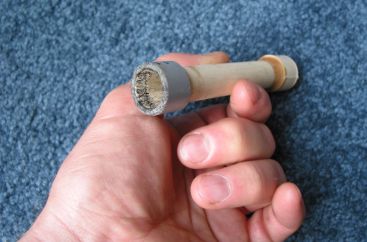 |
Here is a view of the
"funnel" at the open end. This is a slightly narrowing piece of PVC
that helps guide the leather end into the piston cylinder.
Without this, it might be difficult to insert the dowel into the
cylinder. The leather cup might get easily damaged. You may have to do some digging around and trial and error to
find parts that match correctly, and which achieve a match tight
enough yet still allow the rod to move freely within the cylinder.
The goal is to have as little air escape during operation as
possible. The bevelled sleeve is made from a piece of 3/4" pipe
and epoxy glued to the 1/2" piston cylinder. You will have to file
the inside of the 3/4" pipe a bit to get the 1/2" pipe to fit. The
plunger is a piece of 3/8" or 7/16" dowel from a hardware store. I
usually just use a piece of old broom handle for the handle on the
plunger. Total time to construct:
2 hours of actual work over 2 days for all parts: plunger, piston, and
gasket fabrication. |
|
|
|
|
Click on the small photo to
see a movie of this firepiston in operation |
|
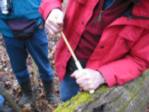 |
|
Windows Media format (WMV)
320x240, 242 KB |
|
|
| |
| In operation, a fire piston doesn't always
produce a coal with the first push of the plunger. Sometimes two or more
pushes are necessary. If this is the case, the plunger should be withdrawn
between pushes, so as to have fresh oxygen in the cylinder.
The plunger should be pushed extremely rapidly, with a
very quick jerk, almost reflexive. If you drive it (push it) in too slowly there may not be
enough air pressure to produce a coal. Brace the base of the fire piston
on something very solid and then drive in the plunger.
|
|
|
|
|